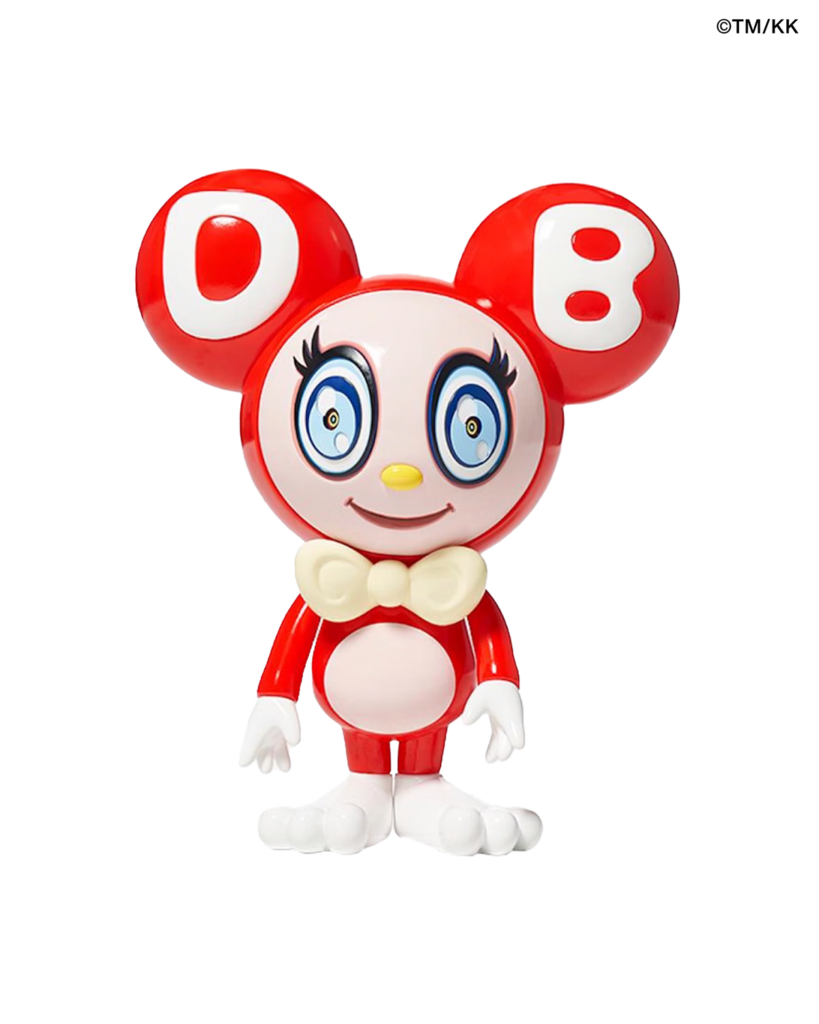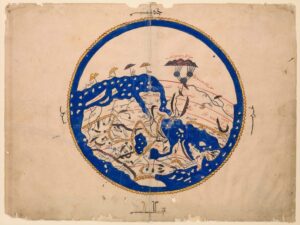Few artists in contemporary art history have blended pop culture, traditional aesthetics, and high-concept artistry as seamlessly as Takashi Murakami. Known for his Superflat movement, Murakami has redefined what it means to be an artist in the modern era, incorporating elements of anime, consumer culture, and traditional Japanese motifs into a distinct artistic style.
Among his most iconic creations is Mr. DOB, a recurring character who serves as a bridge between Japanese otaku culture and Western pop iconography. Over the years, Mr. DOB has taken many forms, but perhaps one of the most striking is the DOB – Camellia Red Statue (Special Box)—a stunning collectible that embodies Murakami’s signature fusion of tradition and modernity.
This limited-edition sculpture represents a bold statement in contemporary art, intertwining Murakami’s thematic exploration of consumerism, identity, and cultural heritage with his unmistakable visual style. But what makes this piece so unique, and why has it captivated both art collectors and Murakami enthusiasts worldwide?
The Origin of Mr. DOB: Murakami’s Answer to Mickey Mouse
To understand the significance of the DOB – Camellia Red Statue, it’s important to first delve into the origins of Mr. DOB, one of Murakami’s most famous creations.
What is Mr. DOB?
Mr. DOB was first introduced in 1993, at a time when Murakami was exploring the relationship between fine art and commercial pop culture. The character’s name, “DOB,” comes from the Japanese slang phrase “dobojite?” (どぼじて?), meaning “why?”, which reflects Murakami’s philosophical questioning of art, identity, and cultural influences.
From a design standpoint, Mr. DOB is often described as Japan’s answer to Mickey Mouse—a character that merges Eastern and Western aesthetics while commenting on the globalization of media and consumer culture. Over the years, Mr. DOB has undergone multiple transformations, sometimes appearing cute and friendly, other times grotesque and monstrous, mirroring the dual nature of modern consumerism—both desirable and overwhelming.
The DOB – Camellia Red Statue: A Fusion of Modern and Traditional Art
A Striking Red Palette and Camellia Motifs
The DOB – Camellia Red Statue stands out with its vibrant red coloration, which plays a significant role in Japanese cultural symbolism. In Japan, red is associated with joy, luck, and protection, making it a powerful and auspicious color.
Beyond its bold monochromatic hue, the statue is adorned with camellia flower motifs, further connecting it to Japanese heritage. The camellia (Tsubaki in Japanese) has long been revered in Japan, symbolizing perfection, devotion, and admiration. By incorporating this motif, Murakami adds a layer of historical depth to an otherwise contemporary and pop-inspired sculpture.
A Limited Edition Collectible in a Special Box
This version of the DOB statue is not just a standalone piece—it comes in a meticulously crafted Special Box edition, further elevating its exclusivity and collectibility.
Key features of the Special Box edition include:
• Premium packaging that showcases Murakami’s famous floral patterns.
• Limited production numbers, making it a highly sought-after item.
• Certificate of authenticity, reinforcing its value as a legitimate piece of contemporary art.
For collectors, the Special Box edition transforms the statue from a simple sculpture into a prized art object, reinforcing Murakami’s exploration of the intersection between fine art and consumerism.
Themes Embedded in the DOB – Camellia Red Statue
Like many of Murakami’s works, this statue is more than just an aesthetically pleasing object—it serves as a commentary on larger cultural themes.
The Role of Consumerism in Art
One of Murakami’s most well-known artistic philosophies is his embrace (and critique) of consumer culture. He has often blurred the line between art and commercial goods, making pieces that are simultaneously luxury collectibles and widely accessible products.
With the DOB – Camellia Red Statue, Murakami once again challenges the traditional notion of what constitutes “fine art”. Is it a high-concept sculpture meant for museum exhibitions? Or is it a commercially produced object designed for mass consumption?
The Mix of High and Low Art
Murakami’s Superflat movement, which draws from both traditional Japanese art and modern pop culture, is perfectly represented in this statue. The use of camellia motifs (a reference to classic Japanese aesthetics) juxtaposed with the cartoonish, exaggerated form of Mr. DOB creates a fascinating clash between historical reverence and contemporary playfulness.
This duality is one of Murakami’s signature strengths—the ability to create art that is both serious and fun, intellectual and accessible.
The Evolution of Mr. DOB as an Artistic Statement
Over the years, Mr. DOB has been interpreted as everything from a mascot of globalization to a critique of capitalism and media saturation. In the Camellia Red Statue, he appears in one of his more refined and polished forms, reinforcing his role as a cultural icon rather than a fleeting pop figure.
Through this statue, Murakami continues his exploration of what it means for a character to evolve in meaning over time, similar to how Disney’s Mickey Mouse or Sanrio’s Hello Kitty have taken on different symbolic roles across generations.
The Market and Collectibility of Murakami’s Work
As with many limited-edition Murakami pieces, the DOB – Camellia Red Statue (Special Box) is highly collectible and likely to appreciate in value over time.
The Growing Demand for Murakami Art
Murakami’s market has remained strong, with his works selling for millions at auctions. Even smaller, more affordable pieces—such as his collectible sculptures—often see resale values increase significantly.
The Appeal to Both Art Collectors and Pop Culture Enthusiasts
Unlike traditional fine art, which often targets a niche audience, Murakami’s work appeals to a broad range of collectors, including:
• High-end art investors who recognize his influence.
• Streetwear and pop culture fans who connect with his playful aesthetics.
• Casual collectors who simply love the fusion of art and pop nostalgia.
Limited Supply, High Demand
With only a limited number of units produced, this statue is set to become a rare and sought-after piece in Murakami’s portfolio. For those lucky enough to acquire one, it represents both an artistic treasure and a smart investment.
Final Thoughts: A Must-Have for Murakami Fans
The DOB – Camellia Red Statue (Special Box) is more than just a collectible—it’s a statement piece that encapsulates Murakami’s artistic vision. Through vibrant colors, cultural symbolism, and a limited-edition presentation, this sculpture highlights why Murakami remains one of the most influential contemporary artists of our time.
For those who appreciate art that challenges conventions, this piece is an essential addition to any collection. It’s a reminder that art doesn’t have to be confined to galleries—it can be playful, commercial, nostalgic, and deeply meaningful all at once.
Whether displayed in an art collector’s home, a modern office, or a carefully curated pop culture archive, the DOB – Camellia Red Statue continues Murakami’s legacy of making art that is both visually stunning and intellectually exquisite.
No comments yet.









